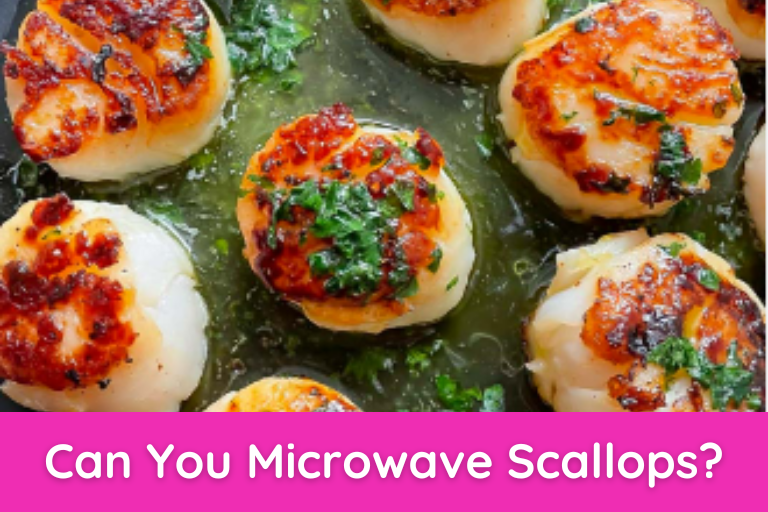Have you ever wondered if it’s possible to microwave scallops? If so, we’ve got the answer for you! Find out if microwaving scallops is safe and how you can get the best results from this quick and easy cooking method.
Can You Microwave Scallops?
Yes! You can quickly and safely microwave scallops. However, you’ll want to take a few steps to ensure the best results. Before microwaving, pat dries each scallop with a paper towel to avoid ruining the texture. Then cook on high heat for 25-30 seconds. Finally, let them sit for 1-2 minutes before digging in!
Can you cook scallops in the microwave?
Yes! You can quickly cook scallops in your microwave. To get the best results, pat dries each scallop with a paper towel before microwaving on high heat for 25-30 seconds. Then let them sit for 1-2 minutes before digging in and enjoying!
Can I microwave stuffed scallops?
Yes, you can microwave stuffed scallops. Make sure to follow the directions on the package and cover the dish before microwaving. Remember to heat in short bursts of 15-20 seconds until heated through. Let the scallops rest for 1-2 minutes before enjoying them!
Can you eat scallops raw?
It is generally not recommended to eat scallops raw. If you choose to do so, it is important to ensure they are fresh and of the highest quality. Raw scallops should also be consumed immediately, and any leftovers should be discarded.
How do you know when scallops are cooked?
Scallops are usually done when they turn opaque and can be easily pierced with a knife or fork. When cooked properly, the exterior should be golden brown, and the inside should still be juicy. You can also check if it’s done by tasting a small piece.
How long should scallops be cooked?
When cooking scallops, it is important to cook them sparingly as this can make them challenging. The general rule of thumb is to cook scallops on each side for two to three minutes or until they are opaque and golden brown. It is also helpful to use a thermometer to measure the internal temperature – when cooked properly, and the internal temperature should reach 140°F.
Are scallops good for you?
Yes, scallops are a healthy and nutritious seafood option. They are high in essential nutrients like protein, vitamins, fats, and minerals. Scallops are also rich in omega-3 fatty acids, which can help to reduce inflammation, improve heart health and boost brain function.
How do you fully cook scallops?
To cook scallops thoroughly, you should start by heating a skillet on medium heat. Add a few tablespoons of oil or butter to the pan and allow it to get hot. Once the oil is hot, add the scallops in one layer so that each side gets equal heat.
Cook for two to three minutes on each side until they are opaque and golden brown. Check that the internal temperature has reached 140°F with a thermometer before serving them as fully cooked.
Can you eat scallops the next day?
Yes, you can safely eat cooked scallops the next day. Make sure to store them in an airtight container and place them in the refrigerator as soon as they cool down. To reheat, add butter or oil to a skillet and heat on medium-high heat. Once it is hot, add the scallops for about two minutes on each side or until heated through.
What is the best way to reheat scallops?
The best way to reheat scallops is in a skillet on medium-high heat. Add butter or oil to the pan and let it get hot. Once hot, add the scallops for about two minutes on each side or until heated through. Check that the internal temperature has reached 140°F with a thermometer before serving them as fully cooked again.
Do scallops get tough if overcooked?
Yes, scallops can get tough if overcooked. This is because the heat causes the proteins in the scallop to contract, resulting in a tough and rubbery texture. To prevent this from happening, remove the scallops from the heat once they reach an internal temperature of 140°F with a thermometer.
Do scallops need to be fully cooked?
Yes, scallops should be thoroughly cooked before being served. Properly cooked scallops have an opaque white or tan colour and a firm texture. To ensure they are cooked through, insert a thermometer into the centre of the most giant scallop to check that the internal temperature has reached 140°F.
Do you need to rinse the scallops before cooking?
It would help if you rinsed the scallops before cooking to remove dirt and debris. Make sure to dry the scallops with a paper towel afterwards, so they don’t become waterlogged when cooking.
Which part of the scallop Cannot eat?
You should not eat the tough, leathery muscle attached to the scallop’s shell. It is okay to leave this part on when cooking, but it should be removed before eating.
Are scallops fish or meat?
Scallops are considered a type of seafood, not specifically fish or meat. However, they are typically closer to the fish category than the meat category.
Why are my cooked scallops rubbery?
If your cooked scallops are rubbery, it likely means they have been overcooked. Scallops should be cooked only until they are done and still slightly translucent in the middle, ensuring a tender, succulent texture.
What do you eat scallops with?
Scallops can be enjoyed in a variety of dishes. They pair well with starches such as potatoes or grains and are often served with vegetables like asparagus or broccoli. Scallops also go great in salads, soups, and stir-fries.
Why are scallops so delicious?
Scallops are a wonderfully delicious seafood option because they are naturally sweet, tender, and succulent. They are also incredibly versatile and can be enjoyed cooked or raw in many different dishes.
How often should you eat scallops?
It would help if you ate scallops as often as you would like, as there are no specific guidelines or recommendations for how often to enjoy them. However, it is important to remember that scallops are a high-cholesterol food, so they should be consumed sparingly. Eating scallops once or twice a month should be sufficient for most people.
Why are scallops chewy?
Scallops can be chewy because they are a muscle, much like other seafood such as shrimp and crabs. When cooked at a high temperature, the muscle fibres of the scallop shrink, causing it to become firm and chewy. To prevent this from occurring and ensure your scallops are tender and succulent, cook them over low heat for short periods.
Why do scallops taste like ammonia?
Scallops can sometimes have a strong ammonia taste because they are stored and frozen for long periods. When scallops are exposed to air, bacteria can grow on their surface, producing compounds such as ammonia, giving them a distinct flavour. To prevent this from happening, buy fresh scallops and prepare them as soon as possible after purchase.
What to do with leftover cooked scallops?
Leftover cooked scallops can be used to make a variety of dishes. They can be added to salads, stir-fries, pasta, and sandwiches for a quick and easy meal. You can add them to soups or chowders for an extra protein boost.
Are scallops high in cholesterol?
Scallops are considered to be a low-cholesterol seafood option. A 3-ounce serving of cooked scallops contains only around 44 milligrams of cholesterol, much lower than other seafood types, such as shrimp or crab. They are also an excellent source of lean protein and can provide important vitamins and minerals.
Conclusion
Scallops can be a delicious and nutritious addition to your diet if cooked correctly. Whether you cook them in the oven, on the stovetop, or even in the microwave, it is important to remember that scallops can become chewy if overcooked. With this knowledge, you can now confidently prepare scallops for any meal!
Do you have any tips or tricks for cooking scallops? We’d love to hear what works best for you – please share your comments below so we can all learn from each other and enjoy our favourite dishes with perfect results every time.




